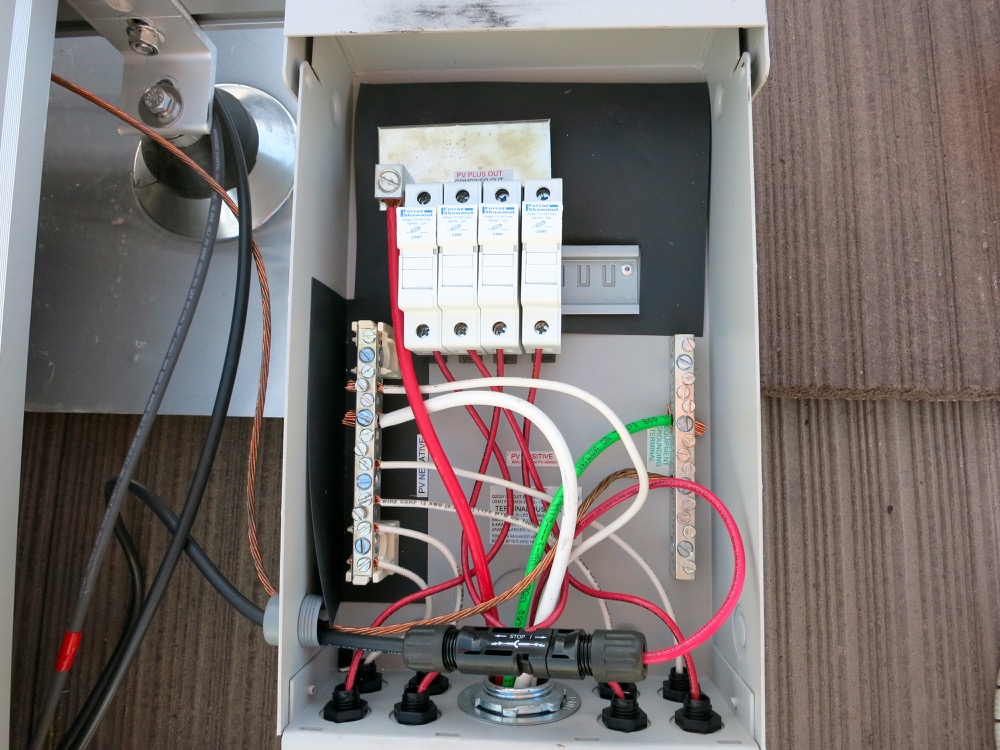Try our solar cost and savings calculator
Most Popular Topics
Collapse
Any issues with adding fuses to my DC Negative inside the combiner box?
Collapse
X
-
-
Can you just use one of the connectors at the bottom?
I think only 6 of the 8 are used, so you should have 1 male and 1 female that are spare.
So why not have the wire for a spare connect to that red wire that's currently connected to the wire coming in the opening.
Of course look at the gauges of the wires - I can't tell what they are - so maybe it wouldn't work because of that.
But if that would work, then that 1/2" opening in the side is completely unneeded and can just be sealed.Comment
-
Made the change to the combiner box, worked out nicely and looks quite professional.
New parts...

Cut off the last leg as only 3 fuses are needed.

Old combiner box setup with unfiused DC-

Took out the old fuses off the DIN rail

Put in new 20A fuses

Ready to re-install in combiner box

And finished product

Before and after

Comment
-
Very nice looking work. If I were the inspector I would not think that any modifications were done.SunnyBoy 3000 US, 18 BP Solar 175B panels.Comment
-
Very nice, and labels are always more important than you first think. Someone didn't tighten
the big lug on my combs, so I soldered them along with the bolt. Looks like you got the MC4
disconnect tool. Mine kept breaking, so I made up well taped metal versions. Bruce RoeComment
-
The assembly looks good but I am not sure about the "White" wiring is correct.
Based on the 3 red wires going to fuses, shouldn't the short white wire (the second from the left) that is now on that termination bar also go to a (negative) fuse?
Also why is the larger white wire (coming out of the 3/4" conduit) going to a fuse? What is it for and does it need to be fused?Comment
-
SunEagle that goes back to what we were talking about before and this schematic...

The thicker white wire is the corresponding DC- for the red DC+ wire coming from plug #2.Comment
-
Ok.
So for my clarity the "Blue" string in your drawing consists of the wire going through your combiner box (using an MC4 connector) to panels on a different section of roof and then coming back on one of those Positive (red wire) MC4 plugs on the bottom of the box. And the Negative for the "Blue" string is coming into the combiner box from the 3/4" conduit running through your attic.
Then the Positive wire for both the "Red" and "Yellow" string come into the combiner box though those Positive (red wire) MC4 plugs while the Negative wires for those strings come in through the Negative (white wire) MC4 plugs.
Just for clarity you might want to label both the Pos and Neg wire for each "string" so (or someone else) knows which string to isolate if they need to work on it.Comment
-
That is correct. Took a little bit of logistics on my end to figure out the best way to do it since the "Blue" string has panels in 3 different locations but it worked out ok.
I should probably do a large sticker label and stick it to the underside of the combiner panel cover showing the schematic of the wiring and then numbers the wires to correspond with the schematic so it's readily available if needed in the future.Comment
-
It might avoid confusion (at least to me) since you have multiple wiring paths with different size wires which for me makes it hard to understand the "circuit' for trouble shooting should it need it.That is correct. Took a little bit of logistics on my end to figure out the best way to do it since the "Blue" string has panels in 3 different locations but it worked out ok.
I should probably do a large sticker label and stick it to the underside of the combiner panel cover showing the schematic of the wiring and then numbers the wires to correspond with the schematic so it's readily available if needed in the future.Comment
-
Yes, good to label everything possible. You'll be glad you did. My box inside has an insulating frontThat is correct. Took a little bit of logistics on my end to figure out the best way to do it since the "Blue" string has panels in 3 different locations but it worked out ok.
I should probably do a large sticker label and stick it to the underside of the combiner panel cover showing the schematic of the wiring and then numbers the wires to correspond with the schematic so it's readily available if needed in the future.
panel which is convenient to label; these are sections of an online custom created bumper sticker.
Also used a colored tape code on both ends of each wire. Bruce RoeAttached FilesComment
Copyright © 2014 SolarReviews All rights reserved.
Powered by vBulletin® Version 6.1.3
Copyright © 2025 MH Sub I, LLC dba vBulletin. All rights reserved.
Copyright © 2025 MH Sub I, LLC dba vBulletin. All rights reserved.
All times are GMT-5. This page was generated at 02:38 PM.
Comment